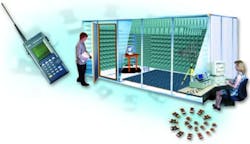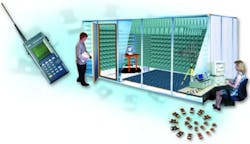Designers often come up with innovative products, and then they find that the products have excessive RF emanations or are susceptible to radiations from elsewhere. EMC engineers constantly evaluate the degree and location of these kinds of problems to find a solution. As a result, the technology of EMC control and the means to accomplish that control are rapidly advancing.
On-the-board help comes in the form of shields, pads, filters, ferrites, and epoxy coating. At the next level, you find gaskets of all types, power filters, special connectors, and shielded cables. For testing, look for antennas, receivers, analyzers, and special software. You also may need a shielded room or chamber. And the list goes on.
This product showcase reflects a continuing increase in the frequencies to be controlled as well as a recognition of the need for tighter control of interference signal amplitudes. The demand for deeper attenuation across a wider frequency band, according to Roy Demcko, product manager at AVX, is driving the EMC industry today. Product after product emphasizes this trend.
Board-Level Products
Four types of RF suppression components attack leakage at its origin. These products feature amplitude-frequency or amplitude-time characteristics designed into the signal paths of circuits to suppress EMI. They are ferrites/high-frequency filters, high-frequency/low-inductance capacitors, transient suppressors/zener diodes, and current-limiting resistors.
“However, even after RF suppression components are added,” commented Ron Brewer, vice president of EMC technical services at Laird Technologies, “in many cases, the RF problem still isn’t solved. Each device introduces intentional or parasitic series inductance or shunt capacitance that alters the circuit design. Even the harmless-looking resistor is guilty. This means that circuit-level components must be considered from the beginning so the possible side effects can be compensated for in the design.
“The optimum compensation is the use of board-level shielding since it solves emission and susceptibility problems without affecting signal integrity. Adding shielding, even after the design is complete, doesn’t cause glitches or crosstalk so it does not require compensation,” he continued.
Since board-level solutions generally are applied in high-volume production, many EMI control products are packaged for tape-and-reel automatic assembly. Even the gasket compound can be dispensed on a production line by a robotic device. And with today’s emphasis on small, lightweight products, new EMC solutions are designed with size and weight as prime considerations.
Product Enclosures
Several types of protection are offered for sealing product enclosures. EMI-safe card cages, gaskets of several types, special connectors, feed-through power-line filters, and honeycomb air filters can be installed. Each manufacturer has attempted to optimize products to the frequency range expected to be encountered.
“The speed of computer-related equipment doubles every 18 months,” George Kunkel, president of Spira Manufacturing, noted, “and the upper RF spectrum increases in the same proportion. The user can’t control RF without gaskets and filters on the product enclosures, paying special attention to the fans and airflow.”
Test Systems and Shielded Rooms
After a product is designed with all the EMC factors taken into consideration, does it meet the qualification tests? That’s where the shielded room, absorbers, and test systems come in. Manufacturers have continued to expand the top frequency coverage for antennas, receivers, and analyzers. You’ll find that the PC is used to a greater extent now more than ever before as designers strive for accuracy, consistency, and speed.
For a small manufacturer, testing laboratories provide an economical alternative to the captive facility. Whether the laboratory is in-house or a contract facility, engineers should involve EMC laboratory personnel before the product is designed and continue through the test and debugging phases.
Return to EE Home Page
Published by EE-Evaluation Engineering
All contents © 2001 Nelson Publishing Inc.
No reprint, distribution, or reuse in any medium is permitted
without the express written consent of the publisher.
October 2001

